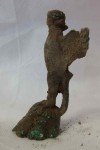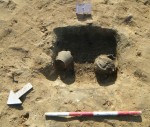 A team from the Colchester Archaeological Trust unearthed the rare Roman bronze figurine of a harpy in Brightlingsea on the southeastern coast of England. Archaeologist Ben Holloway discovered the petite four-inch high piece in September of last year during the preventative excavation of a section of the Moverons Quarry before gravel quarrying was slated to begin there. The artifact was in the top layer of fill in a field-boundary ditch that also had Roman pottery sherds and fragments of imbrex, Roman overlapping clay roof tile.
A team from the Colchester Archaeological Trust unearthed the rare Roman bronze figurine of a harpy in Brightlingsea on the southeastern coast of England. Archaeologist Ben Holloway discovered the petite four-inch high piece in September of last year during the preventative excavation of a section of the Moverons Quarry before gravel quarrying was slated to begin there. The artifact was in the top layer of fill in a field-boundary ditch that also had Roman pottery sherds and fragments of imbrex, Roman overlapping clay roof tile.
It is quite finely detailed, and is in the form of an upright bird with a woman’s head and with small wings which are fully open. The figure has feathers and talons, and braided hair; however, it seems to have a serpent’s tail which functions as a support. It is standing on a damaged base and also seems to have been attached at the top of the support.
 The figurine has not been cleaned or conserved yet, so more details will be forthcoming. There is no indication from the context of why it ended up in the quarry site. It could have been anything from a discard to a votive offering. Its design is similar of the feet found on small, portable charcoal braziers Romans used for indoor heating.
The figurine has not been cleaned or conserved yet, so more details will be forthcoming. There is no indication from the context of why it ended up in the quarry site. It could have been anything from a discard to a votive offering. Its design is similar of the feet found on small, portable charcoal braziers Romans used for indoor heating.
Two braziers donated by Marcus Nigidius Vaccula to the Forum Baths and Stabian Baths of Pompeii in the late 1st century A.D. have harpy feet that look very much like larger versions of the Brightlingsea figurine. A bronze brazier called a foculus was used in the tepidarium to heat the air to a constant warm temperature.  Bathers would sit on benches next to the brazier to get a good schphitz (ad flammam sudare) going before moving on to the hot waters of the caldarium.
Bathers would sit on benches next to the brazier to get a good schphitz (ad flammam sudare) going before moving on to the hot waters of the caldarium.
The tepidarium was often the central room of the Roman bath complex and was the most elaborately decorated. Elegant architectural features like mosaic floors, marble inlays, sculpted support pillars and intricate reliefs were the setting for the most expensive high-end art works. The largest Roman sculptural group ever found, the breathtaking Farnese Bull, was discovered in the tepidarium of the Baths of Caracalla.
 Although they have discovered evidence of thousands of years of habitation at the quarry site, from a Bronze Age ring-ditch to Anglo-Saxon huts, archaeologists have not found any conclusive evidence of Roman baths. They closest they came was a tile from a hypocaust, the underfloor hot air system used to heat baths and pricier homes, but they believe it was part of Roma farmhouse or villa in the area. Indeed, archaeologists found the remains of Roman field systems in the quarry, plus three Roman cremation burials from the 2nd-3rd century. If the harpy was part of a brazier, it was likely used in the home.
Although they have discovered evidence of thousands of years of habitation at the quarry site, from a Bronze Age ring-ditch to Anglo-Saxon huts, archaeologists have not found any conclusive evidence of Roman baths. They closest they came was a tile from a hypocaust, the underfloor hot air system used to heat baths and pricier homes, but they believe it was part of Roma farmhouse or villa in the area. Indeed, archaeologists found the remains of Roman field systems in the quarry, plus three Roman cremation burials from the 2nd-3rd century. If the harpy was part of a brazier, it was likely used in the home.
As an aside, the figurine was found just weeks after this same team found the hoard of jewelry hidden from Boudicca’s army Roman treasure at the Williams & Griffin store excavation in Colchester. What a productive few months they’ve had.
So cool! I love reading about Roman finds.
Ah… a pity that they don’t give us a photograph from the rear of the piece. They’re the experts, so it probably is a lizards tail as they say, but from the front it looks like it flares out at least to one side nearing the lower terminus. That makes me think it could be a bird’s tail still, just thickened to support and allow for the metal to flow during casting. Either way, it will be gorgeous to see even more detail once it is cleaned. I wonder what her nest is made of, spread over the… rocks? That doesn’t look like “traditional” harpy nesting material.